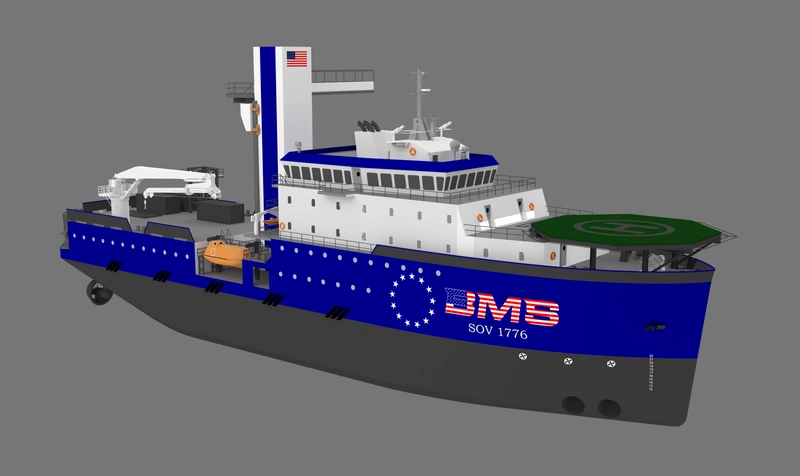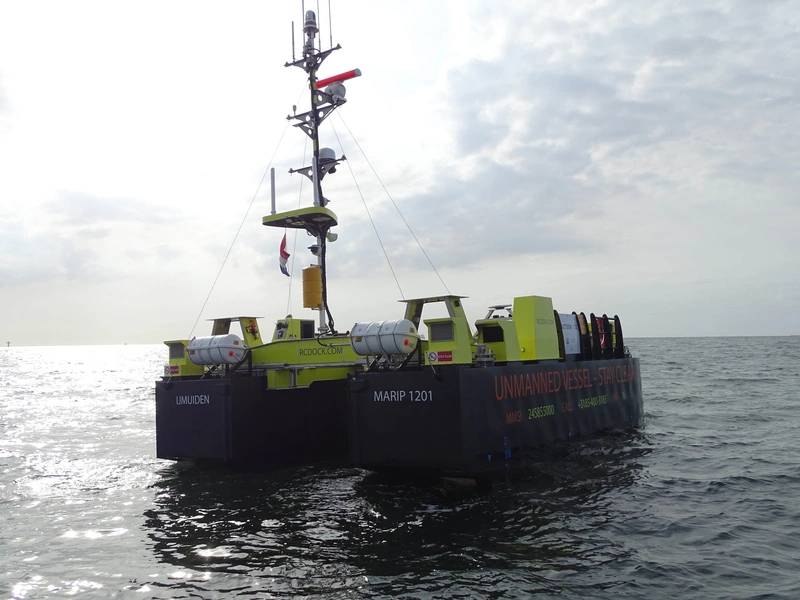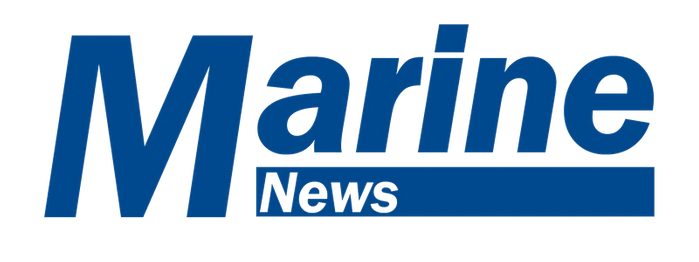Tech Files
Tech Files: Offshore Wind
Marine News highlights some of the latest vessels and technologies making waves in the offshore wind industry.

BMS Unveils SOV Design for the US Offshore Wind Market
Covington, La. based marine engineering firm Baker Marine Solutions has unveiled a new service operation vessel (SOV) design for the U.S. offshore wind industry. The new 275-foot (LOA) BMS 1776 is designed be built in the U.S. to ABS class standards and is fully certified to operate in U.S. waters, utilizing U.S. offshore workers, BMS said. The SOV will have a breadth of 57 feet and 19-foot draft.
"With the U.S. offshore wind industry expanding rapidly, U.S. companies must be ready to build SOVs designed specifically for U.S. shipyards to support the installation and maintenance of domestic wind farms," said BMS president Jim Baker. "The BMS 1776 brings this capability back home."
The BMS 1776 has been created with the goal to reduce carbon emissions in the design, construction, operation and maintenance of the vessel, BMS said. For example, hull optimization studies from MARIN increased hull efficiency by 23%, resulting in a top speed of 13.5 knots.
The vessel is spec’d with a state-of-the-art BlueDrive PlusC system from Siemens. Variable-speed generators will allow engines to run at optimal speed set points based on most-efficient fuel consumption and torque capability. In addition, an available hybrid battery system can store excess energy and enable peak shaving when required.

MATS, A New Uncrewed Platform for Offshore Wind
Survey, positioning and data management firm UTEC, part of the Acteon Group, is targeting the offshore wind survey and inspection market with a new uncrewed surface vessel (USV). Torsten Marten, lead surveyor, UTEC, outlined the new design at the Marine Autonomous Technology Showcase (MATS), at the National Oceanography Center (NOC) in Southampton, UK, early November.
It’s a 12m-long, “DP equivalent” catamaran design, developed to offer a stable platform for survey and inspection operations, using vessel-based sensors and an up to 3-tonne remotely operated vehicle (ROV) capacity including the LARS (launch and recovery system), he said.
The first one was launched in August, with sea trials completed in October. It has two moon pools, with retractable poles for sensor deployment, can travel up to 2,600nm with up to 27-day endurance, 10kts transit speed and up to 7kts survey speed.
It’s a totally unmanned and modular surface vessel, initially targeting offshore wind cable and seabed survey and ROV general and close visual inspection, operating from any port, Marten said.
“It’s one of the largest and most stable USVs in the commercial market,” he said. “The catamaran design gives it additional stability. Because it has an ROV, it can combine geophysical survey and ROV inspection.” That makes it ideally suited to offshore wind farms for where you want to do cable inspection surveys and monopile visual surveys, he said.
Hull mounted sensors can include multibeam, side-scan sonar, sub bottom profiler, USBL systems, an acoustic modem for data harvesting and environmental sensors.
Read more in the December edition of Marine Technology Reporter magazine.
Jan De Nul's Giant Jack-up Vessel Delivered
Offshore installation specialist Jan De Nul Group said its flagship newbuild jack-up vessel, Voltaire, had left the COSCO Shipping Shipyard in China and was heading for Dubai. The vessel was delivered by the shipyard on December 15.
"With her crane capacity of 3,000 tons, four immense legs of 130 meters, and capacity to lift 16,000 tons of useful cargo out of the water, Voltaire is the world’s tallest jack-up installation vessel," Jan De Nul said.
The vessel will be used for offshore wind installation and offshore decommissioning work. Jan De Nul said in March that the Voltaire had been fitted with what it said was the world's largest leg encircling crane.
The Voltaire has been designed to install the offshore wind turbines of the future, with turbines over 270 meters high and blades 120 meters long.
The vessel will transport, hoist and install offshore wind turbines, transition pieces, and foundations.
For these lifting works, the vessel was equipped with a main crane of more than 3,000 tonnes.
For its first project, the jack-up will mobilize to the United Kingdom for the construction of the 3.6 GW Dogger Bank offshore wind farm, the world’s largest offshore wind farm, transporting and installing a total of 277 GE Haliade-X turbines of up to 14 MW.
BAR Targets US CTV Deployment for 2024
Marine engineering consultancy, BAR Technologies (BAR), revealed its low-emission crew transfer vessel (CTV) design, the BARTech 30, will be available for the first U.S. offshore wind projects in 2024, following quotes at several U.S. shipyards.
BAR said it was met with the U.S. offshore wind vessel supply chain at a workboat show in New Orleans in anticipation of license agreements that will see the CTV type built in the U.S.
According to the company, with its 30m ProA design, and active foiling systems to correct for pitch and roll, the BARTech 30 is able to minimize vessel motion and fuel burn – leading to an average increase in stability across all sea states of up to 70% and a reduction in total emissions of 30% over a typical operational profile - making the vessel one of the first Low Emission Vehicles (LEVs) serving offshore wind farms.
Additionally, BAR says, with the vessel able to operate in more challenging conditions than the current catamaran designs, offshore wind turbines may be serviced over a greater number of sea states, ensuring wind farm owners have more opportunities to better and more cost-effectively provide turbine maintenance.
BMT Unveils New Crew Transfer Vessel Model
BMT has unveiled its new 32-meter hybrid propulsion crew transfer vessel design, citing industry demand for lower carbon emissions, capacity and prolonged offshore operations.
"Crews and engineers’ safety and comfort are fundamental to BMT’s approach with this design. Spaces around the vessel have been carefully arranged to improve workflow. The wheelhouse has been designed to offer outstanding visibility to facilitate crew transfers. The superstructure is resiliently mounted and significantly reduces noise and vibration," BMT explained.
According to the company, at 32 meters (105ft), the vessel’s size has been increased for a larger cargo deck area and increased load capacity. This will enable the vessel to play an increased role during the windfarm construction phases, with the ability to carry more equipment in support of the larger ships, BMT said.
This design features BMT’s Active Fender System, "an essential feature that enhances transfer capability in a wider range of sea states, as well as the safety of the technician transfer in challenging sea conditions and reduces the potential for impact damage to the vessel or turbine structure."
World's First Methanol-powered CTV
Offshore wind turbine maker Vestas and offshore vessel owner Northern Offshore Services (N-O-S) have partnered to deploy the world’s first methanol-powered offshore crew transfer vessel (CTV) to drive down emissions from offshore wind service operations. The CTV, provided and developed by N-O-S, will be powered by a dual-fuel solution, capable of being powered by methanol, but also able to fall back on marine gas oil if methanol is not available.
Vestas has signed a five-year charter to explore how the vessel can help reduce carbon emissions from its offshore service operations. The vessel will be deployed in Vestas’ service operations at the Arcadis Ost site offshore Germany, owned by Parkwind, in 2023.
"Green methanol fuel emits significantly lower levels of carbon dioxide, signaling the potential to drastically reduce carbon emissions while maintaining the same power output," N-O-S said, noting that the CTV holds the potential to reduce carbon emissions by 70% compared to a traditional vessel, and this carbon reduction potential will be validated during the charter.
“Service vessels drive a significant portion of Vestas’ direct carbon emissions, and while there are several promising new technologies that provide a solution to this challenge, many are still in the early stages of maturity. To drive decarbonization, we need to see solutions like methanol fuel maturing much faster. Industry leaders can accelerate this journey by lending their support,” said Kieran Walsh, Senior Vice President, Service, Northern & Central Europe, Vestas.
EnCap Backs Houston-based Firm to Build Jones Act WTIVs
Houston-based Bleutec Industries, a company that describes itself as the builder, owner and operator of Jones Act-compliant offshore wind turbine installation vessels (WTIV), said it has secured "a significant capital commitment" from EnCap Investments L.P. “Partnering with EnCap, a strategic capital provider with a strong track record facilitating portfolio company growth, provides the necessary support for Bleutec to quickly develop our Jones Act vessels in order to build our competitive advantage in this nascent market,” said Robin Bodtmann, Bleutec Chief Executive Officer.
The specifications of the vessels that Bleutec intends to build are impressive; according to the company, they will be able to install offshore wind turbines with capacity of up to around 22 megawatts (MW). These turbines don't exist yet.
The company is focusing on "binary marine installation solution" (BMIS), which it described is a cost-effective alternative to the more expensive heavy-lift jack-up WTIVs that are currently used by the offshore wind sector for foundation and turbine installation. According to Bleutec, the BMIS will be built around a piling installation vessel (PIV), a wind turbine installation vessel light (WTIVL) and service operation vessels (SOV). The PIV will feature a gantry crane, capable of lifting up to 4,500 metric tons, a hydraulic hammer and deck space for the piles. The WTIVL will install wind turbines of up to ~22 MW on the foundations and the SOVs will provide the necessary accommodation and crew support services. Deployment is expected to take place during the early part of 2026.
Finland-based marine equipment and engine supplier Wärtsilä said it had signed a memorandum of onderstanding with Bleutec Industries, covering Wärtsilä’s role as the system integrator for Bleutec’s BMIS. All vessels making part of the BMIS are designed to be powered by Wärtsilä dual-fuel engines paired with Wärtsilä’s hybrid battery energy storage systems, and, according to Wärtsilä, will incorporate the latest advances in dynamic positioning.
